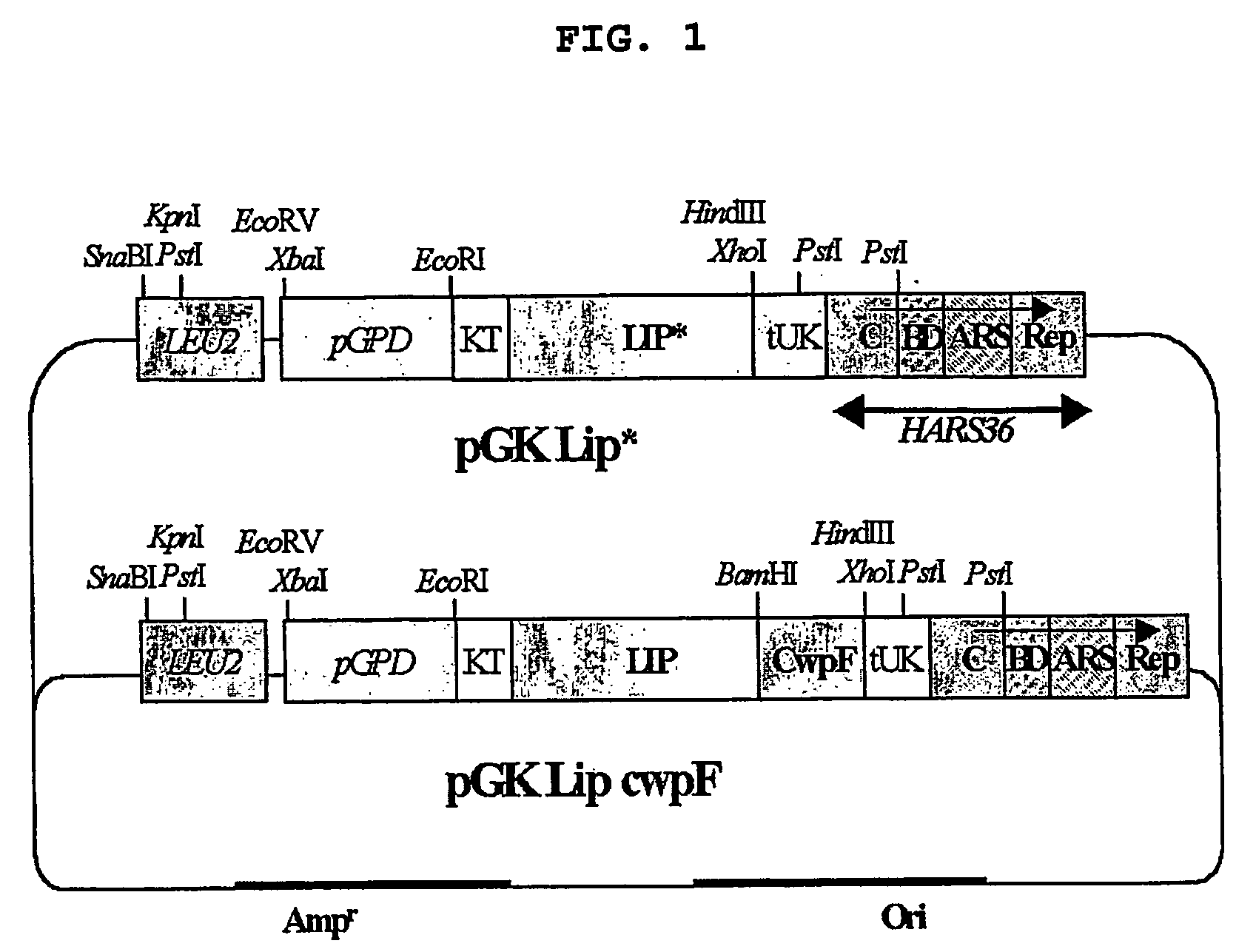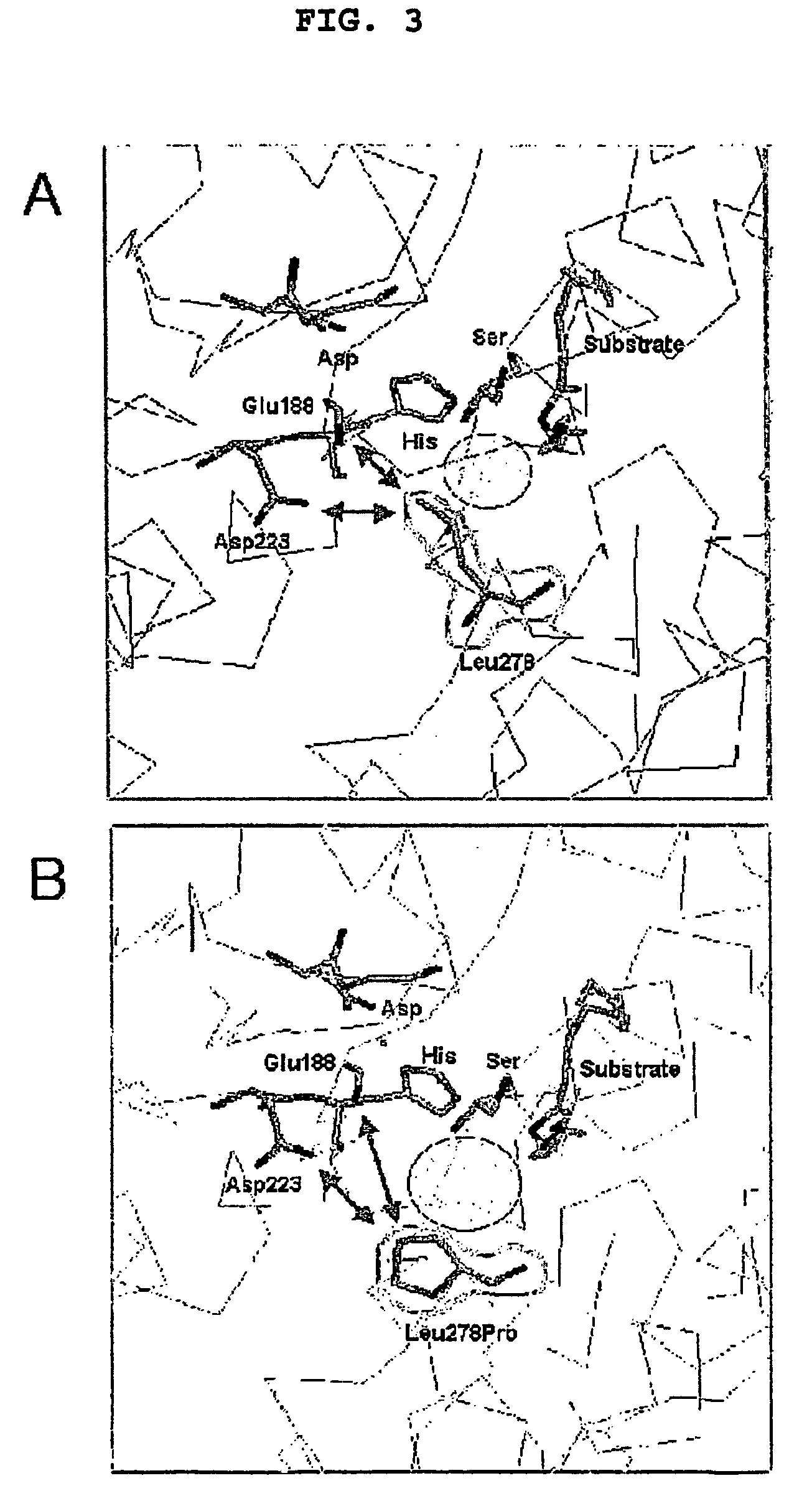Method for screening of a lipase having improved enzymatic activity using yeast surface display vector and the lipase
- Summary
- Abstract
- Description
- Claims
- Application Information
AI Technical Summary
Benefits of technology
Problems solved by technology
Method used
Image
Examples
example 1
Preparation of CALB Expressing Vector and Transformant
[0085] The present inventors constructed a vector expressing CALB on the surface of H. polymorpha or secreting the protein out of the cell.
[0086] Particularly, in order to construct a vector to secrete CALB to the media, CALB gene was first obtained from Candida Antarctica genome by polymerase chain reaction (PCR) using primers represented by SEQ. ID. No 1 and No 2. The PCR for the synthesis of CALB was performed using pfu polymerase (Stratagene, USA) at 94° C. for 3 minutes and 15 cycles of denaturation at 94° C. for 1 minute, annealing at 55° C. for 1 minute, and extension at 72° C. for 1 minute, followed by a final extension at 72° C. for 10 minutes. Thereafter, the gene was identified by sequencing analysis. CALB gene was digested with SapI to make it blunt-ended and digested again with BamHI. The gene was inserted into KpnI and BamHI regions of a vector, a kind of Hansenula polymorpha expression vector AMIpL1 (Agaphonov et...
example 2
Construction of a Library by In Vivo Recombination
[0090] In order to establish CALB mutant library, the present inventors used in vivo recombination, which was once reported in S. cerevisiae (Abecassis et al., Nucleic. Acids. Res., 2000, 28, E88). For the establishment of CALB library, this method was adapted to Hansenula polymorpha.
[0091] In vivo recombination is the method in which cells are transfected with a vector fragment and a synthesized insert fragment having homology with the vector in both ends of the DNA fragment together, so that an authentic circular vector is produced by the recombination therein. The in vivo recombination is simple and efficient method with no need to establish a library in advance in E. coli, so the method can be effectively used especially for the establishment of a library composed of genes fatal to E. coli.
[0092] The pGK-Lip-CwpF, a vector expressing CALB on the cell surface, was digested with EcoRI / PstI, resulting in the obtainment of 5 kb fr...
example 3
Construction of CALB Mutant Library
[0094] In order to construct CALB mutant Library, the present inventors used error-prone PCR and in vivo recombination.
[0095] Particularly, error-prone PCR was performed with primers represented by SEQ. ID. No 4 and No 5 using pGK-Lip-CwpF, a vector expressing CALB on the cell surface, as a template. PCR random error-prone kit (Clontec, USA) was used to induce 2-5 errors per 1 kb. DNA fragments were recovered after being cut by required size on gel. Amplification PCR was performed with those fragments by using PCR premix kit (Bioneer, Korea) with primers represented by SEQ. ID. No 4 and No 5 at 94° C. for 3 minutes and 25 cycles of denaturation at 94° C. for 30 seconds, annealing at 55° C. for 30 seconds, and extension at 72° C. for 1 minute, followed by a final extension at 72° C. for 7 minutes.
[0096] 100 ng of the fragment obtained by the above process and 100 ng of the 5 kb vector fragment obtained by digesting pGK-Lip-CwpF with EcoRI / PstI we...
PUM
| Property | Measurement | Unit |
|---|---|---|
| Temperature | aaaaa | aaaaa |
| Temperature | aaaaa | aaaaa |
| Temperature | aaaaa | aaaaa |
Abstract
Description
Claims
Application Information
 Login to View More
Login to View More - R&D
- Intellectual Property
- Life Sciences
- Materials
- Tech Scout
- Unparalleled Data Quality
- Higher Quality Content
- 60% Fewer Hallucinations
Browse by: Latest US Patents, China's latest patents, Technical Efficacy Thesaurus, Application Domain, Technology Topic, Popular Technical Reports.
© 2025 PatSnap. All rights reserved.Legal|Privacy policy|Modern Slavery Act Transparency Statement|Sitemap|About US| Contact US: help@patsnap.com



